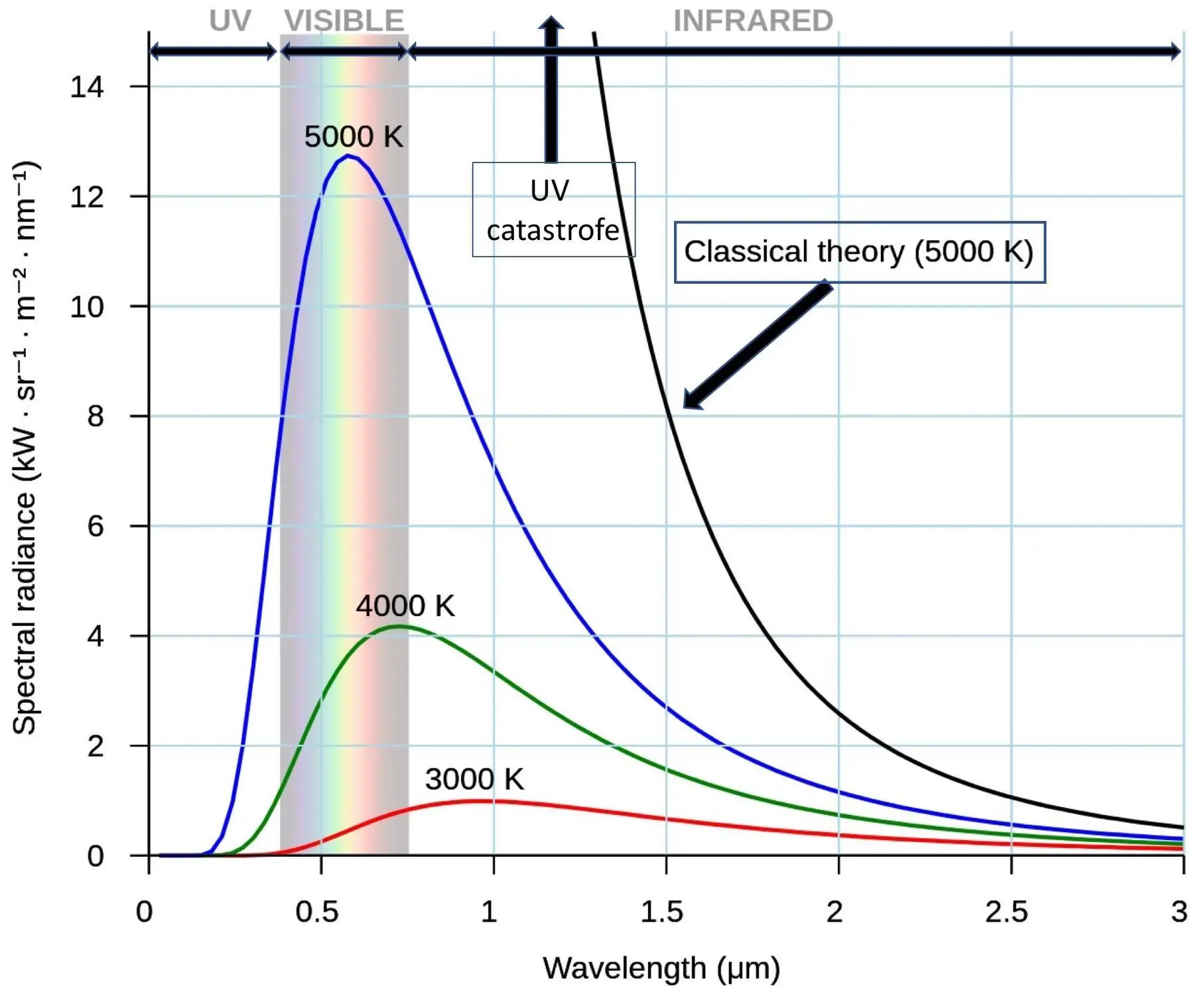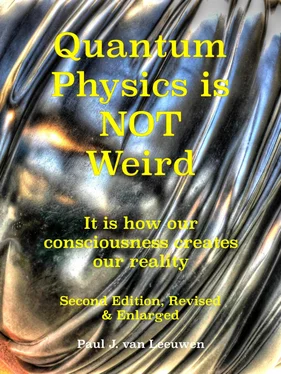Figure 3.12 illustrates the intensity distribution of EM radiation at different temperatures of a "Black Emitter", an emission spectrum. The far-right curve, – going through the roof at a wavelength around 1.3 micrometer (μm) – is the theoretically calculated behavior for a temperature of 5000 oK. It predicts a continuously sharply increasing radiation intensity at decreasing wavelengths, which is the UV catastrophe.

Figure 3.12: Black Body emission spectrum compared with UV-catastrophe.
Source: Wikimedia Commons.
The other three curves represent the reality, the measured intensity distribution for absolute temperatures of 3000, 4000, and 5000 oK. At a temperature of 5000 oK the maximum of the radiation emitted by a Black Emitter is located exactly in the middle of the visible light spectrum, between 0.4 and 0.7 μm. That is also – and certainly not by coincidence – the temperature of the photosphere, the radiant outer shell of our sun. Our eyes are optimized for our own local star. The real 5000 oK curve shows you that the intensity of Black Body emission at a temperature of 5000 oK drops quickly for the shorter wavelengths of UV radiation, and beyond 0.2 μm it vanishes entirely.
Physicists had tried to calculate the theoretical Black Body emission applying classical physics in a similar way as Ludwig Boltzmann [1 7 ]had successfully done for gases. They combined Boltzmann’s statistic methods with Maxwell's laws. To achieve this, they imagined vibrating electrical charges in the inner walls of the Black Body emitter. Based on the Maxwell equations, those vibrating charges should emit and absorb EM radiation in all possible frequencies from infrared to very deep ultraviolet.
But according to classical physics theory, an unimaginably huge amount of ultraviolet radiation would be emitted by a white-hot glowing Black Body. The disturbing fact that the classical physics prediction totally derailed in the UV domain – see the rightmost curve in figure 3.12 – challenged physicists like Max Planck to find a correctly predicting theory with outcomes corresponding with measured intensities.
Planck had, by heuristic trial and error, already found a formula that fitted the measured emission spectra for different temperatures. This success was already very useful, of course, but what he really was after, was a theory derived from the basics. He did a heroic attempt to derive his heuristic formula from the bottom-up. To that end, he tried – with great reluctance and just as a last resort – the assumption of discrete energy packages of EM radiation that would be emitted and absorbed by the vibrating electrical charges in the walls of the Black Body emitter. He assigned to those discrete energy packages a precise amount of energy proportional to their frequency and gave them a name: quanta.
Eureka! His last resort attempt delivered the correct emission predictions and dealt completely with the UV catastrophe. In 1900 Planck published the first quantum theory, ‘Zur Theorie der Wärmestrahlung’, in the Annalen der Physik [1 8 ]. Later Planck confessed that his inspiration was born out of desperation. In his desperate attempts, seeking a way out, he assumed that the energy exchange of such an EM quantum – which Albert Einstein later supposed to be a real energy particle – was proportional to the frequency f . Which gives us the formula that every physics student now knows by heart, Planck’s Law: E =h .f .
The utterly small value of h – Planck's constant: 6,626 × 10 −34Joule seconds – is now engraved on his headstone. With this daring last resort assumption, he was able to derive the correct equations for the emission of a Black Body emitter completely from basic physics principles and arrived thus at the perfect prediction for the spectrum of the standard light source. Goal achieved; you would suppose. But the kinder reactions from his colleague physicists were that it was a nice trick at best, but that these quanta could not have anything to do with physical reality. Such peer responses on a groundbreaking idea are not uncommon in the history of science. Only in 1918 Planck justly received the Nobel Prize in Physics, 18 years after his publication and only after Einstein had explained the photoelectric effect with Planck's quanta. Despite this success, Planck and other physicists, were not able to explain how an electromagnetic wave first expands spherically according to Maxwell, its intensity diminishing inversely proportional to the square of the distance to the source, to change then abruptly into the very local and precise amount of energy transfer represented by the Planck quantum. The question is also, whatever it is to be imagined by the frequency of a quantum. This is precisely the problem that the remaining sections of this book will focus on.
Planck did search a long time extensively for a ‘classical’ solution, but that evaded him. He was indeed not too happy with his quantum assumption because it could not be reconciled – and still not – with the generally accepted wave theories of Huygens, Young and Maxwell. Until the end of the 19 thcentury, energy transfer had been considered as a continuous phenomenon, such as water flowing from a tap. You can fill a container slowly with a thin stream of water, or you can turn the flow up when you are in a hurry. A small, strong jet yields the same amount of water as a broader but weaker jet. EM radiation transports energy but behaves entirely different. Consider for example the effect of UV light on your skin. You will never acquire a bronzed skin by sitting patiently in front of a strong infrared source, such as a central heating radiator.
The success of Planck's formula was the beginning of the end of the absolute deterministic view of the world of classical physics. If classical physics would be right, the past and the future of the universe would be fully known by the infamous demon of Laplace. It is at this moment in history that physics encounters a phenomenon that unquestionably shows that there had to be a false premise, hidden somewhere in her basic assumptions about nature. A paradox emerged, unwilling to leave. The idea of a quantized wave, of discrete packets of EM energy, could in no way be reconciled with Maxwell’s EM-wave model. In such a position we have two options:
we either give up and decide that human imagination simply falls short and that we just must accept the paradox,
or we decide to investigate our basic assumptions about reality to establish what could be wrong there.
In the end, Planck proved to be a courageous out-of-the-box thinker. In 1931 he changed his views on physics radically demonstrating this by stating:
“ I consider consciousness to be fundamental. I consider matter as derived from consciousness. "
We will see later why this is a well-argued position. In my opinion is Max Planck the icon of the courageous scientist.
First, he followed his interest in physics going against the common stream.
Secondly, he was not satisfied with a mathematical expression that accurately predicted the observations but failed to reveal its fundaments. He wanted to understand what happens basically and therefore searched until he had found a way to derive his expression from basic principles. That he had to make uncomfortable assumptions did not stop him. He was willing to put aside his "this-is-how-it-is" ideas. He ignored his cognitive dissonance.
Thirdly, because of his courage to come out with a result that would be received in the scientific world with disapproval and rejection. A risky action that seriously could have damaged his career. Just think how long it took for him to be awarded a Nobel prize for physics, 18 years.
Читать дальше













